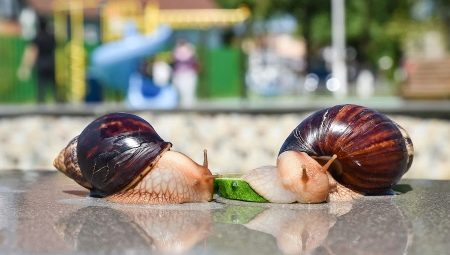Interesting and original Achatina snail pets become pets in many families. These creations were spread in East Africa, and now they can be found in the homes of any country in the world. They earned their popularity for their exotic appearance and low maintenance.
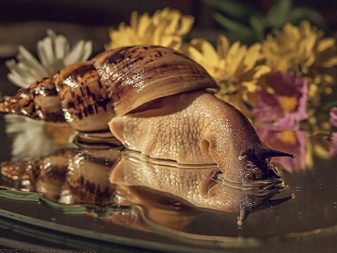
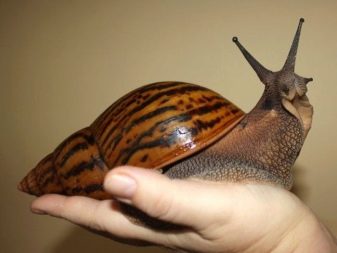
Growing conditions
Despite the unpretentiousness of snails, for their maintenance it is necessary to create certain conditions.
Terrarium
As a terrarium for a snail, a plastic or glass container is suitable. The container should have a massive well-reinforced lid with holes. Achatina belong to land mollusks, and therefore it is not necessary to fill the selected container with water.
The volume of the aquarium is chosen at the rate of 10 liters per individual, for an adult snail a terrarium of 40 cm long, 25 cm wide and 25 cm high will be required. Both gigantic species and small snails are able to gnaw even dense material, so boxes will not work as a home.
The aquarium should be clean, no clouding should be present on the walls:
- through the dull walls of the pet will not be visible;
- access to light will be difficult.
therefore all walls must be transparent. Inside, you need to organize a feeding place and a drinking bowl, put up a pool, equip a shelter - they can be, for example, a ceramic pot or coconut shell.
When arranging a terrarium, try to avoid objects that are too hard and sharp, as they can injure achatins. As decorations, you can use moss, shards, bark, it is allowed to plant plants.

Substrate
Filler is vital to the African snail. For the mollusk, soft soft soil should be selected, in which there are no sharp fragments. The amount of covered substrate is calculated by the dimensions of the cochlea: it is important that it can be completely buried. Usually for an adult Achatina, a layer of 5-7 cm is enough, for a young compact snail you do not need to fill up a lot of soil, otherwise it will suffocate. The most popular varieties of soil are several options.
- Coconut substrate. This filler retains moisture for a long time. Before filling them with an aquarium, the substrate is sprayed with boiling water, then cooled, washed, dried and placed on the bottom of the terrarium.
- Horse clean peat. If this type of filler is used, then the acidity should remain at the level of 5-7.
- Sand. Snails like this kind of soil, however, particles can scratch, injure the shell, leave damage on the walls of the terrarium. Experienced breeders combine coarse loose sand with non-acidic soil.
- Compost. This is a good option if it does not contain fertilizers, but snail owners note that when using this species, fruit midges can appear in the terrarium and in the house.
Unsuitable for use are sawdust, pebbles, shells, even classical soil will not work, as it may contain fertilizers and other dangerous components. It is allowed to use synthetic winter shelters, and lay moss or dry foliage on top.
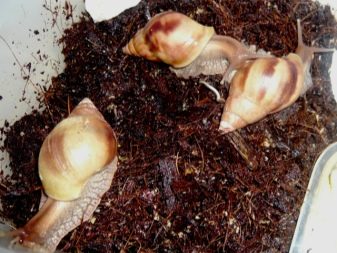

Temperature mode
This is a thermophilic animal, the temperature recommended for its keeping is + 24 ... 28 degrees Celsius. To maintain the mode, you can use thermal mats, thermal cords, lighting devices. When cold weather, Achatina becomes lethargic and may even hibernate. Overheating is also dangerous. To control the temperature, do not forget to get a thermometer.
Do not leave the terrarium near the battery or other heating devices, so that the humidity indicators do not decrease, and the soil does not dry out. And Protect the aquarium from direct sunlight.
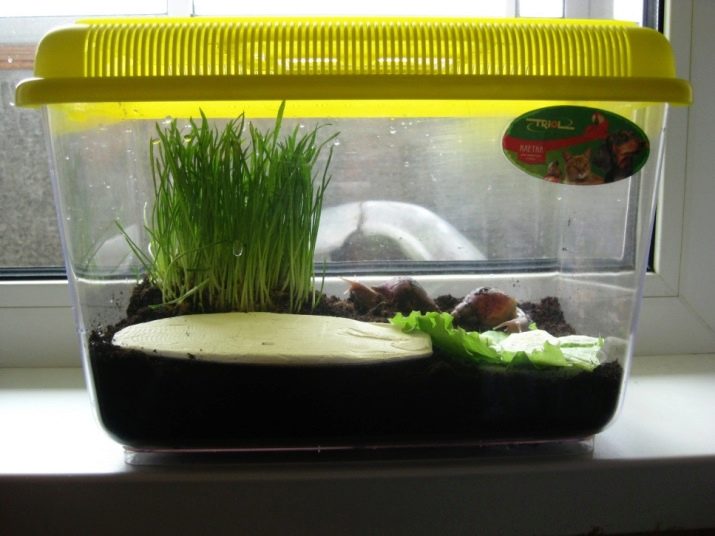
Humidity
Humidity is the most important indicator for the content of snails. IN In arid conditions, Achatina feel uncomfortable; they bury themselves in a substrate or take cover in a sink. In order not to cause discomfort to your pet, organize a small pool in the terrarium.
The basis can be any capacity. The main thing is that it be heavy, and the snail could not turn it over. And also to maintain humidity, you need to spray the terrarium and its bottom with water a couple of times a day. Recommended humidity for most species is 70-85%, for albopic - 90%.
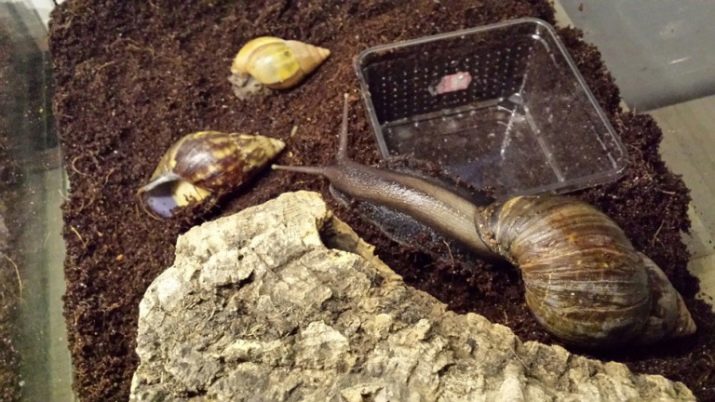
Lighting
The visual organ of the snails is located on the antennae, and therefore these animals are very sensitive to light. So that the pet does not go blind, it is impossible to use powerful bright lamps for lighting. And also it is not allowed to put the terrarium on the south window, where ultraviolet rays fall. Use weak lighting, be sure to turn off the light at night.
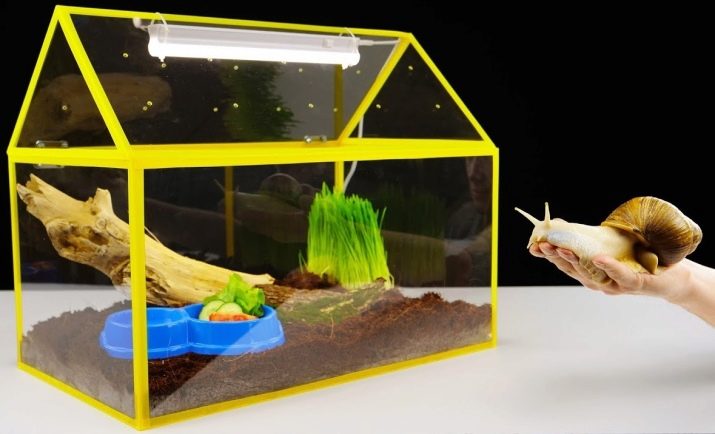
The subtleties of feeding
The main diet of snails is plant food. Cucumbers, leaf lettuce, apples are the favorite treats of Achatina.
This creature does not disdain and street herbs - clover, dandelion, leaves. Carrots, corn, and zucchini will also be useful. As an additional treat, you can offer the snail bran or oatmeal. The most important component of the menu should be foods high in calcium. So, an egg shell or feed chalk can become an excellent source of this element. Do not refuse to feed with special additives and vitamins for reptiles.
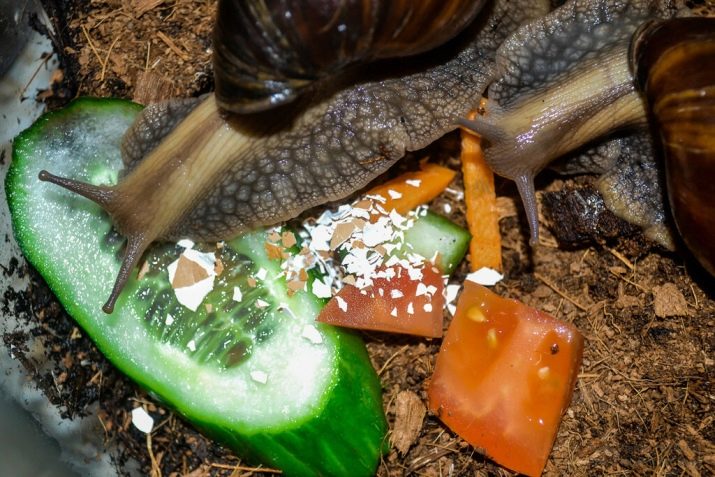
Only offer snails that have been thoroughly washed and shredded.Young individuals are fed every evening, and in the morning the remaining food fragments are removed.
Adult snails are enough to feed a couple of times a week.
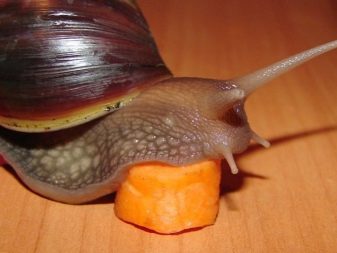
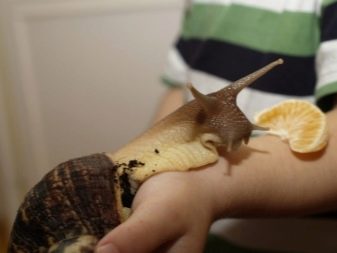
For the proper maintenance of Achatina, the owner must take care not only of food, but also of water for his pet. Without fluid, it is impossible to secrete fluid, the cochlea needed for life. therefore in the terrarium there should always be a small container with water, it is customary to change the water every two days.
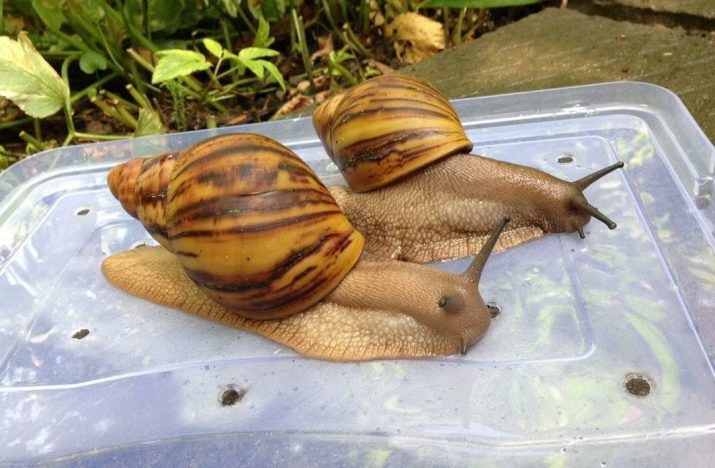
How to clean the aquarium?
General cleaning in the terrarium is carried out once a month. Cleaning is done step by step:
- the aquarium is cleaned of old filler;
- the container is thoroughly washed with running water and dried well;
- then fill the tank with a new substrate;
- moisturize the substrate by spraying with water from a spray bottle.
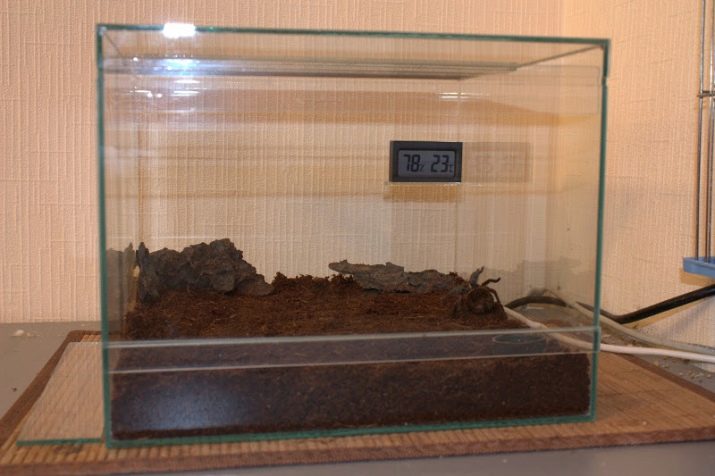
Hygiene
As already mentioned, it is advisable to put a pool in the terrarium. Here the snail will perform water procedures. Do not fill the tank to a too high level, especially if small snails live in the terrarium. Mollusks can move under water, but young ones can be drowned due to distraction. Water in the pool should be at room temperature, it needs to be changed every day.
Periodically, Achatina needs a shower. For this, bathing with warm water above the tap is suitable. The snail at the time of the shower procedure is held in the palm of your hand. All manipulations last a maximum of 3 minutes.
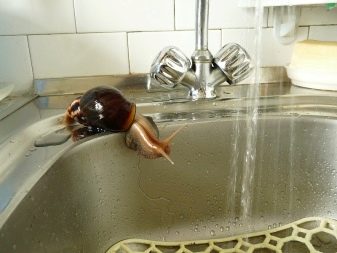
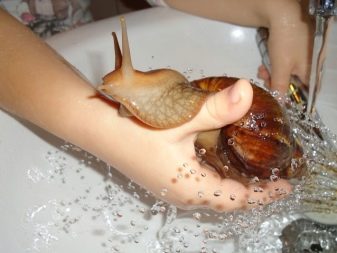
Winter Care
Due to the inaccessibility of fresh fruits and vegetables, the snail's menu in winter becomes poor. Lowering the temperature and lack of moisture affect the state of Achatina, so many of them hibernate. This is a non-hazardous phenomenon for the animal, but an inexperienced owner may be frightened, noting that the pet does not show signs of life for two months.
To avoid this phenomenon, it is important to continue to comply with all the rules of maintaining and caring for the cochlea: to maintain the diet, maintain the temperature regime and humidity indicators.
It is good if you manage to grow greens for your pet in the winter at home on your own. In the cold months, it is allowed to feed with oatmeal, bran, low-fat dairy products, whole-bread soaked in water.
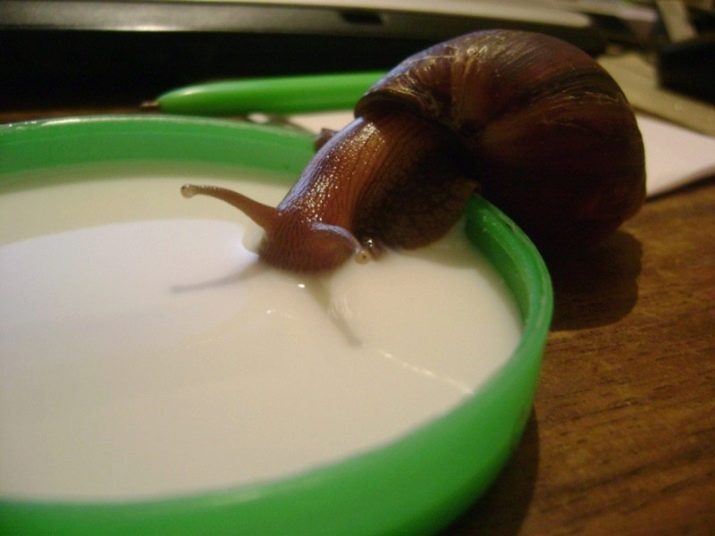
How to care for eggs and babies?
Every owner who has decided to breed Achatina snails, I must know a few facts about the reproduction and care of eggs and young animals.
- Achatina has both male and female genital organs, that is, it refers to hermaphrodites. Depending on the type of incubation period varies.
- Pregnancy can be determined by an egg sac formed near the respiratory opening a couple of weeks after crossing. A pregnant snail produces masonry within two days, buried in the ground. At one time, 200-400 eggs are obtained, although not all are viable. Cubs hatch 2-4 weeks after masonry.
- Achatina are very prolific animals, and often the owner has to wash off part of the eggs to control the number of individuals. Sometimes this happens by accident, so be careful when cleaning the terrarium.
- As soon as the first calves emerge from the eggs, plant them from adults in a separate terrarium with salad leaves.
- The first lure for posterity can be liquid porridge, supplemented with grated carrots. These products contribute to the full growth and strengthening of the shell.

Hibernation and awakening
The animal can be put to sleep for the following reasons:
- sharp temperature changes;
- stress situation, for example, a change of terrarium, diet, substrate;
- cooling;
- moisture deficit.
Most often, owners observe this phenomenon in the winter. Before deep sleep, the pet is closed with a special film called the epiphragm. In general, there is nothing dangerous in hibernation, but if the snail continues to sleep for more than two months, then it will lose an irreplaceable part of its moisture, and this can already destroy Achatina.Due to the loss of moisture, the mollusk decreases in size and digs deeper into the shell, the body becomes more and more fluid.
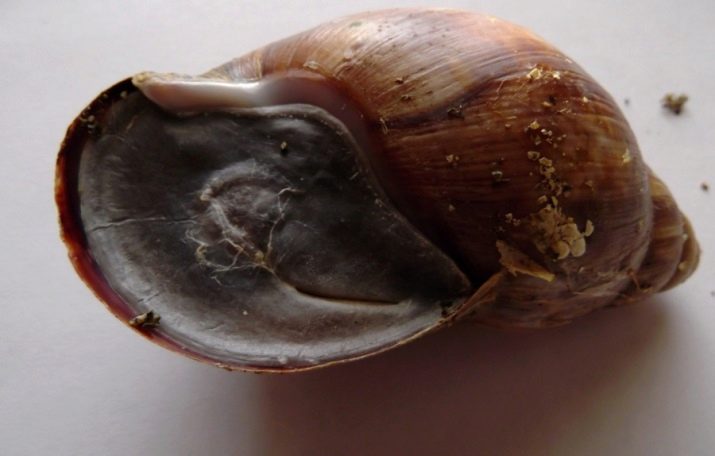
Sometimes owners specifically enter the snail into a state of sleep, for example, during vacation, when there is no one to care for the animal. For this, the mollusk is placed in a container with a dry substrate, do not moisten the aquarium, the animal is not fed. Under these conditions, the snail will fall asleep. Young individuals are prohibited from hibernating, otherwise it will adversely affect the growth and development of Achatina.
If the snail sleeps for more than two months, then the owner is forced to wake her.
The easiest way is to place your pet under a stream of warm water. Feeling moisture, the snail looks out of the sink, and then it must immediately be left in the terrarium with the usual conditions for it. Next, the pet is sprayed with water.
If the reason for hibernation was a violation of the temperature regime, then it is required to return the previous indicators. And also in this case, you need to change the ground and bathe a snail in water with a decoction of chamomile (+36 degrees) and milk. If the mollusk does not wake up, the procedure is repeated once every two days, until it peeks out of the shell.
Having noticed that the animal is preparing for hibernation, it is important to prevent this phenomenon. The following measures will serve as prevention:
- add high calcium ingredients to the menu;
- wash the snail regularly, keep the terrarium clean;
- watch the air temperature and humidity in the aquarium.

Possible problems
A problem in keeping a pet may be its disease. In general, these are animals with fairly good health, but such a misfortune as a disease does not always bypass them. The following symptoms indicate an ailment:
- passivity of the cochlea;
- loss of appetite;
- blockage of the entrance to the sink;
- excessively thick mucus;
- shell stratification;
- whistling and hissing, which during pain achathine.
An animal is sick if hypothermia or overheating occurs in the terrarium. Also, the causes of illnesses can be a tight container, a substrate that is too dry or wet, poor hygiene, accumulation of rotten uneaten food fragments, the formation of mold and mildew on the walls, monotonous nutrition, protein and calcium deficiency. To treat the mollusk from parasites, breeders use iodine, ointment with propolis, the drug "Mikoseptin."
Sometimes it becomes a problem shell injury. A snail may fall, or a dispersed owner may accidentally crush it with something, resulting in a violation of the integrity of the shell. Small defects can be treated with an antiseptic, large breaks and cracks are eliminated with epoxy glue.
If such a misfortune occurred with a pet, it is important to put it away from other individuals during the healing of the shell, as these creatures like to rub shells against each other.
In order to prevent injury to the shell, it is important to observe the following rules:
- always take the snail with clean and damp hands, but before that do not use soap, cream or other hygiene products;
- Do not tear your pet away from the wall of the aquarium and do not squeeze it between your fingers so as not to injure the sink and damage internal organs;
- Take the snail not by the shell, but by the sole.
Sometimes the problem is determining the death of a pet. Not all owners are able to recognize that the animal has died, and continue to care for it. If, when touched, the snail does not instinctively draw its head and body into the carapace, then this indicates its death. The same applies to the situation when the sink has been sealed for a long time and the snail cannot be woken up.
Seeing that the snail has fallen out of the shell, it can also be assumed that she died, or this is waiting for her in the near future. Death is also indicated by the unpleasant smell of a rotten egg, which has spread throughout the terrarium.

Review Reviews
In general, the reviews of the owners about African snails are positive, although there are some disadvantages of these animals. The benefits include ease of maintenance as well as cost-effective maintenance. So, the main costs are necessary only when Achatina appears in the house (buying an aquarium, lighting, filler, houses), and then this animal will practically not require any expenses. And also among the pluses there is a lack of smell, which other pets cannot brag about.
Separately, the owners talk about the benefits of these snails. It turns out their mucus is used in medicine and cosmetology. Some housewives leave the animal on the face, abdomen or in areas where cellulite has formed.
It is believed that the therapeutic mucus of Achatina is able to get rid of wrinkles, scars, stretch marks, pigmentation, it is able to tighten the skin, relieves tension, is used during massage.

The cons of these pets judging by the reviews of the owners include them feature to make noise when crawling at night, that is, when rubbing against the surface an unpleasant sound is heard. However, this property was not noticed by all owners, mainly this phenomenon is observed for pets who use sand as a litter. Possible disadvantages include the appearance of a smell from rotting products, in time unnoticed and not cleaned by the owner.
Some users say that when escaping, these animals are quite difficult to find in the apartment. Owners of certain species express an opinion about their favorites. So, reticule breeders advise you to purchase a rather large terrarium, and owners of albino snails recommend not to be scared if the animal grows slowly - apparently this is characteristic of albinos, and besides, such snails are more demanding in care.
You can learn more about the snail Achatina by watching the video below.
